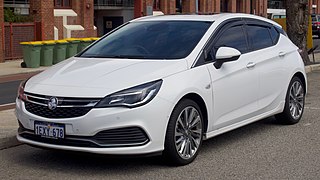
The Holden Astra is a small car formerly marketed by Holden. The first couple of generations of Astra were made only for Australia, and was a derivative of the locally produced Nissan Pulsar. With the Button car plan coming into effect, it was replaced by the Holden Nova, a rebadged Toyota Corolla.

The Holden Camira is a mid-size car that was produced by Holden between 1982 and 1989. It was Holden's version of GM's J-body family of cars—GM's third "global" car platform. The name "Camira" comes from an Aboriginal word meaning "wind."
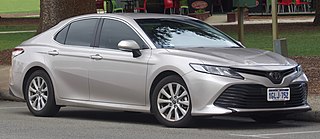
The Toyota Camry is an automobile sold internationally by the Japanese auto manufacturer Toyota since 1982, spanning multiple generations. Originally compact in size (narrow-body), the Camry has grown since the 1990s to fit the mid-size classification (wide-body)—although the two widths co-existed in that decade. Since the release of the wide-bodied versions, Camry has been extolled by Toyota as the firm's second "world car" after the Corolla. As of 2022, the Camry is positioned above the Corolla and below the Avalon or Crown in several markets.

The Toyota Vitz is a subcompact car produced by the Japanese automobile manufacturer Toyota from 1999 to 2019 in a three- or five-door hatchback body styles. The "Vitz" nameplate was used consistently in Japan, while most international markets received the same vehicle as the Toyota Yaris, or as the Toyota Echo in some markets for the first generation. The Vitz was available in Japan from Toyota's Netz Store dealerships. Toyota began production in Japan and later assembled the vehicle in other Asian countries and in France.
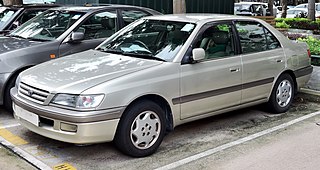
The Toyota Corona is an automobile manufactured by the Japanese automaker Toyota across eleven generations between 1957 and 2001. On launch, the Corona was Toyota's second-highest product in their range, just below the Crown. The Corona was marketed in the JDM at Toyota's Toyopet Store dealership channels, and the Corona was one of Toyota's first models exported to other global markets, followed by the smaller Toyota Corolla.

The Nissan Sunny is an automobile built by the Japanese automaker Nissan from 1966 to 2004. In the early 1980s, the brand changed from Datsun to Nissan in line with other models by the company. Although production of the Sunny in Japan ended in 2004, the name remains in use in China and GCC countries for a rebadged version of the Nissan Almera.

The Geo Prizm and Chevrolet Prizm were compact cars that were rebadged versions of the Toyota Sprinter, a vehicle that the Japanese automaker Toyota never directly sold in the North American market. The Sprinter itself was derived from the Toyota Corolla. The Prizm was marketed under the Geo nameplate until it was discontinued after the 1997 model year. After that, the vehicle was marketed under the Chevrolet nameplate. General Motors (GM) referred to this and other Toyota Corolla derived vehicles as the GM S platform. The cars were produced from 1988 to 2001 alongside the Corolla at NUMMI, an assembly plant operated as a joint venture of GM and Toyota. The Prizm was sold exclusively in the United States and succeeded the 1985–1988 Chevrolet Nova, which was also derived from the Sprinter and produced at NUMMI.

The Toyota Sprinter is a compact car manufactured by Toyota as a variant of the Toyota Corolla. Exclusively sold in the Japanese domestic market, the Sprinter was aimed to be sportier than its Corolla sibling and also using different sheet metal mostly on the C-pillar. The Sprinter was sold exclusively at the Toyota Auto Store while the Corolla was sold at the eponymous Toyota Corolla Store, which focused on economical cars compared to the more upmarket Vista store.

The Nissan Pulsar is a line of automobiles produced by the Japanese automaker Nissan from 1978 until 2000, when it was replaced by the Nissan Bluebird Sylphy in the Japanese market.

The Kia Sephia is a compact car that was manufactured by the South Korean automaker Kia Motors from September 1992 to 2003.

The Hyundai Excel, also known as the Hyundai Pony, Hyundai Pony Excel, Hyundai Presto, Mitsubishi Precis, Hyundai X2 and Hyundai XL, is an automobile which was produced by Hyundai Motor Company from 1985 to 1999. It was the first front-wheel drive car produced by the South Korean manufacturer. The Excel range replaced the rear-wheel-drive Hyundai Pony.
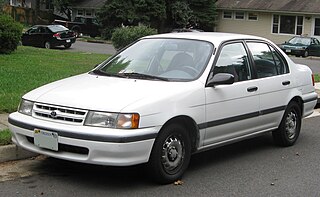
The Toyota Tercel is a subcompact car manufactured by Toyota from 1978 until 1999 across five generations, in five body configurations sized between the Corolla and the Starlet. Manufactured at the Takaoka plant in Toyota City, Japan, and sharing its platform with the Cynos and the Starlet, the Tercel was marketed variously as the Toyota Corolla II — sold at Toyota Japanese dealerships called Toyota Corolla Stores — and was replaced by the Platz in 1999. It was also known as the Toyota Corsa and sold at Toyopet Store locations. Starting with the second generation, the Tercel dealership network was changed to Vista Store, as its badge engineered sibling, the Corolla II, was exclusive to Corolla Store locations.
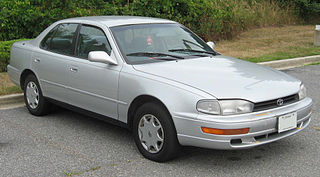
The Toyota Camry (XV10) is a mid-size car that was produced by Toyota between 1991 and 1996 in Japan and North America, and 1993 and 1997 in Australia. The XV10 series represented the third generation of the Toyota Camry in all markets outside Japan, which followed a different generational lineage. The XV10 Camry range is split into different model codes indicative of the engine. Four-cylinder models use the SXV10/SDV10 codes, with VCV10 designating the six-cylinder versions, and MCV10 the later six-cylinder cars in North America only.
United Australian Automobile Industries (UAAI) was an automobile model joint venture that operated in Australia between 1987 and 1996 as the result of an agreement between Holden and Toyota Australia. The joint venture resulted in the two companies sharing production of locally produced automobiles by selling their models under both brands.

The Corolla E90, introduced in 1987 for the 1988 model year, was the sixth generation of cars sold by Toyota under the Corolla nameplate. It was the last generation of Corolla to be classified as a subcompact car and the first to be exclusively front-wheel drive or all-wheel drive; the performance option of rear-wheel drive was dropped.

The Corolla E100 was the seventh generation of cars sold by Toyota under the Corolla nameplate. This generation of Corolla was larger, heavier, and visually more aerodynamic than the model it replaced. With its 2,465 mm (97.0 in) wheelbase, the Corolla had moved into the compact size class once occupied by the Corona and Camry. The Corolla again had an equivalent model Sprinter, with the Sprinter Trueno being equivalent to the Corolla Levin and both exclusive to Toyota Vista Store Japanese dealerships.
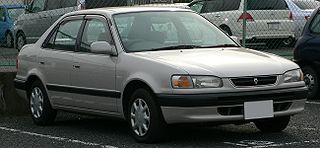
The Corolla E110 was the eighth generation of cars sold by Toyota under the Corolla nameplate.
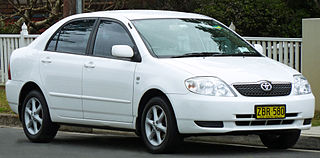
The Toyota Corolla (E120/E130) is the ninth generation of compact cars sold by Toyota under the Corolla nameplate. In Japan, this series arrived to the market in August 2000; however, exports were typically not achieved until 2001 and 2002 depending on the market.

The Toyota Corolla E80 is a range of small automobiles manufactured and marketed by Toyota from 1983 to 1987 as the fifth generation of cars under the Corolla and Toyota Sprinter nameplates, with production totaling approximately 3.3 million, and most models adopting a front-wheel drive layout.

The Toyota Corolla (E210) is the twelfth generation of the Corolla, a compact car (C-segment) manufactured by Toyota. Introduced in 2018, this generation has also grown to include hatchback and estate configurations in addition to the saloon (sedan).




























